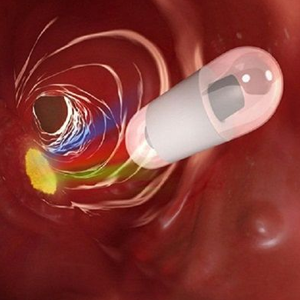
Capsule Endoscopy

Capsule Endoscopy
Capsule endoscopy is a medical procedure that uses a small, swallowable capsule to visually examine the inside of the gastrointestinal (GI) tract. Here's an overview:
Types of Capsule Endoscopy
1. Small Bowel Capsule Endoscopy : Examines the small intestine.
2. Esophageal Capsule Endoscopy : Examines the esophagus.
3. Colonic Capsule Endoscopy : Examines the colon.
Procedure
1. Preparation : Patient fasts for 12 hours before the procedure.
2. Swallowing the Capsule : Patient swallows the capsule, which is about the size of a vitamin pill.
3. Capsule Movement : The capsule moves through the GI tract, taking thousands of images.
4. Data Transmission : The capsule transmits images to a recorder worn by the patient.
5. Procedure Duration : Typically takes 8-12 hours.
6. Capsule Excretion : The capsule is excreted naturally.
Indications
1. Small Intestine Disorders : Diagnose bleeding, inflammation, or tumors.
2. Celiac Disease : Monitor intestinal damage.
3. Crohn's Disease : Monitor intestinal inflammation.
4. Gastrointestinal Bleeding : Identify source of bleeding.
5. Abdominal Pain : Investigate cause of chronic pain.
Benefits
1. Minimally Invasive : No sedation or endoscopy required.
2. Comprehensive Imaging : Thousands of images captured.
3. Improved Diagnosis : Accurate diagnosis of small intestine disorders.
Risks and Complications
1. Capsule Retention : Rarely, the capsule may get stuck.
2. Intestinal Obstruction : Rarely, the capsule may cause an obstruction.
3. Allergic Reactions : Rarely, patients may experience allergic reactions.
Contraindications
1. Pregnancy : Capsule endoscopy is not recommended during pregnancy.
2. Gastrointestinal Obstruction : Patients with known obstructions should not undergo capsule endoscopy.
3. Pacemakers : Patients with pacemakers should not undergo capsule endoscopy.
Preparation and Aftercare
1. Fasting : Patient must fast for 12 hours before the procedure.
2. Hydration : Patient should drink plenty of water during the procedure.
3. Monitoring : Patient's vital signs and capsule movement are monitored.
4. Follow-up : Patient returns to the doctor to review results and discuss further treatment.
